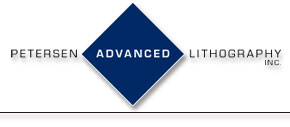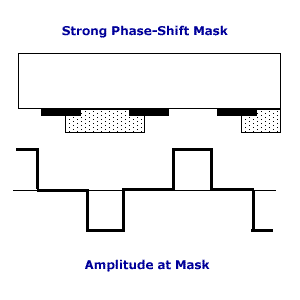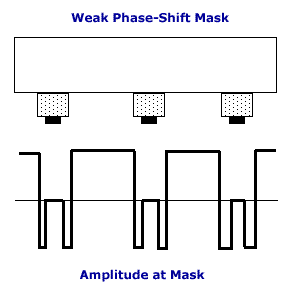


 |
 |
 |
 |
 |
 |
 |
PAL can design and manufacture customized test masks and reticles. Properly-designed masks take into account lens and illuminator limitations, mask topography and optical proximity effects.
In addition we write software to automate the generation of parameterized litho simulation mask files, in GDS-II and other formats such as PROLITH *.msk format. Click here for more information on custom software from PAL.
PAL provides several types of physical test reticles:
- Strong Alternating Phase-Shift Masks, including SCAA
- Weak High Transmission Attenuated Phase-Shift Masks
- Dark-field Phase-Shift Masks
"Strong"
Alternating Phase-Shift Masks
"Strong" phase-shift masks eliminate the zero-diffraction order
light and increase resolution using a technique called frequency doubling.
To understand how strong shifters work, imagine the critical pitch as
having alternating clear areas adjacent to the opaque feature. Because
of the alternating phase regions, the pitch between the same phase regions
is doubled. This doubling cuts in half the position the diffraction orders
would ordinarily
take through the projection lens relative to the critical pitch, thus
making it possible to image features with half the pitch allowed by conventional
imaging. When the two opposing phase regions combine to create the final
image, their zero order light is equal in magnitude, but of opposite phase,
thus canceling each other out.
Strong phase shift masks use on-axis illumination.
Real strong phase-shift masks exhibit non-ideal unequal intensities in
the two opposing phase regions, so designers apply various correction
schemes. PAL offers SCAA masks, which make most corrections unnecessary.
In some applications, other approaches are required, such as the asymmetric
bias. Further discussion of these masks can be found in PAL
publications, "Multiple Pitch Transmission and Phase Analysis of
Six Types of Strong Phase Shifting Masks."

"Weak"
High Transmission Attenuated Phase-Shift Masks
"Weak"
shifters dampen, but do not eliminate, zero order light. They form their
phase shift between adjacent features by creating electric fields of unequal
magnitude, and of opposite phase, with the field immediately adjacent
to the critical feature having the lower magnitude. The combined electric
field limits the magnitude of the zero order while maintaining the appropriate
phase. The shifter region can be a subresolution feature adjacent to the
primary feature, or the primary feature itself can be partially transmitting
with the right phase shift. Weak phase shift masks use off-axis illumination
to achieve the two-beam imaging.
These masks can improve imaging potential while reducing the level of
optical proximity correction needed for small features and limiting the
mask error enhancement function. PAL can provide high transmission attenuated
phase shift masks for imaging line and space features and contact holes.
At
193 nm and 248 nm, 6% to 42% (and higher) test mask transmissions are
available.

Dark-Field
Phase-Shift Masks
Simply
put, dark-field phase-shift masks consist of an opaque surface with the
desired features cut out. Because they eliminate unwanted phase-shifting,
dark-field masks are known to provide better imaging potential than bright-field
masks. Can be weak or strong shifted.
Back to top
Please note that currently these plates are for experimental use only.
|
© 2003 Petersen Advanced Lithography, Inc. |